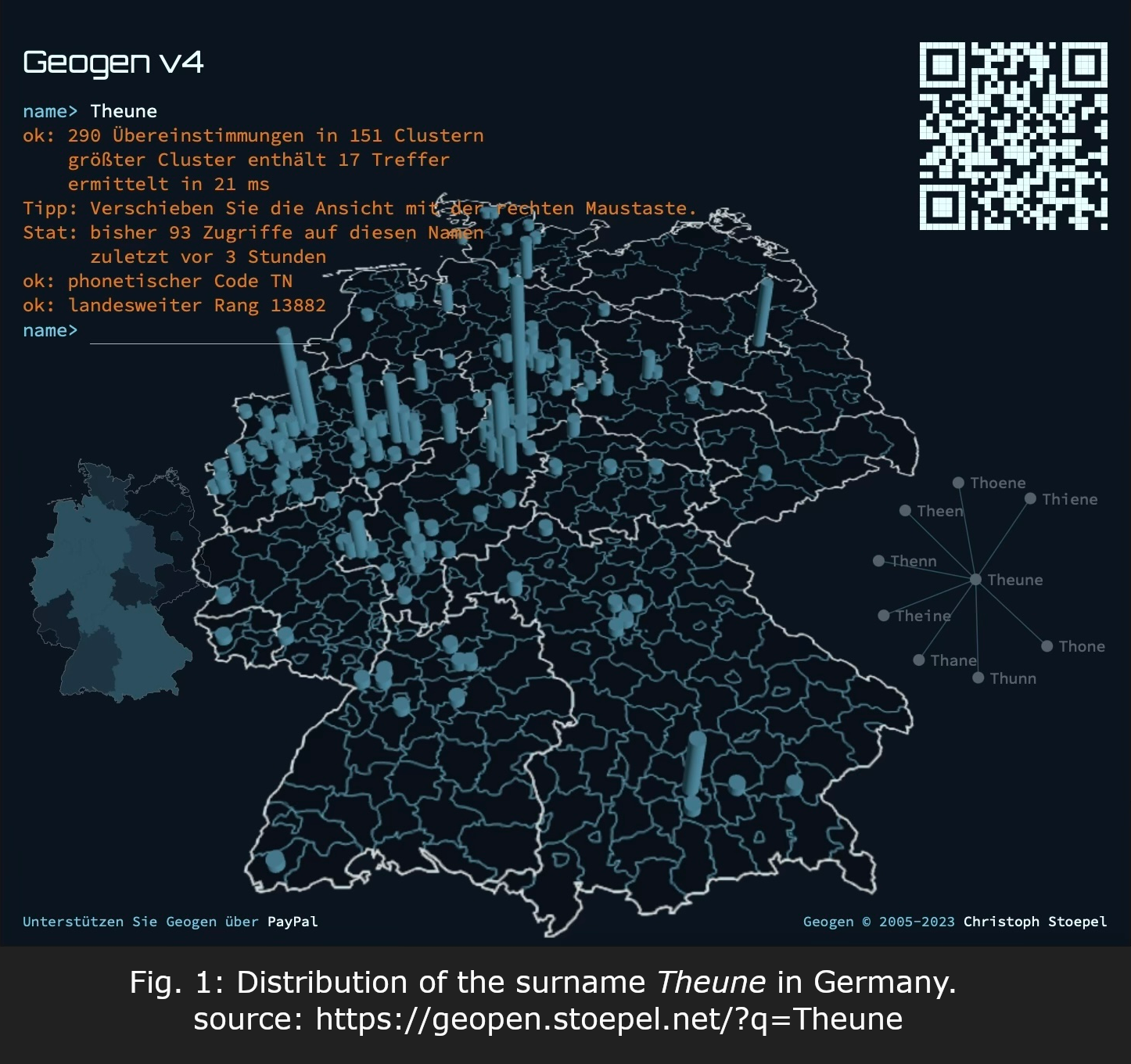The Origin of Our Surname
Your family name is Theune and you have been wondering where it originates from?
Your search is over! Here is the explanation!
Your family name is Theune and you have been wondering where it originates from?
Your search is over! Here is the explanation!
This site is under construction.
The emergence and significance of family names can be traced back to the necessity for distinct identification in medieval societies. In European history, the Middle Ages refers to the era between the end of antiquity and the beginning of the modern period, roughly spanning the 6th to the 15th century. Initially, a single given name sufficed for individuals, akin to modern first names. However, the growth of urban centers, increased trade, and the advent of written administrative records necessitated more precise methods of identification. This was particularly challenging due to the popularity of certain given names, such as Johann (or Hans), Friedrich, Elisabeth and Anna, which were shared by a significant portion of the male and female population throughout the German-speaking regions, reflecting the religious and cultural influences of the Middle Ages. To address this, the use of secondary names, or bynames, became essential. These bynames were influenced by various factors, including paternal lineage, occupation, geographical origin, residential location, or distinctive physical or character traits. Initially, these bynames were flexible and could change depending on the context, and they were not hereditary.
However, as written administration expanded, the need for fixed, inheritable surnames grew, allowing for precise identification and the tracing of familial lineages. This transition from variable bynames to permanent family names occurred at different rates across regions, influenced by factors such as population density and social status.
In the German-speaking territories, hereditary surnames began to appear in the southwest during the 12th century, spreading northeastward and becoming widespread by the end of the Middle Age (e.g. 16th century). Urban areas and higher social strata adopted surnames earlier than rural regions and lower classes. Over time, family names evolved, influenced by oral usage, dialectal variations, and standardization in written form, asking the precise determination of their original meaning and motivation for their creation often complex.
The interpretation of the surname Theune is connected to the linguistic context of its origin, necessitating an initial delineation of the name's geographical roots. A preliminary insight into the region of its emergence can be derived from the current distribution of the name within the German-speaking area. For this purpose, registered telephone listings can be helpful as a onomastic resource providing comprehensive data.
Since the number of landline connections in Germany peaked in the late 1990s with around 300 entries, whereas in 2025, only approximately 90 landline connections are left over, it is difficult to map and analyze up-to-date data. While nearly 3 people lived together in one household in the late 1990s, in the average, the trend toward single-person households has become established, with the average now decreasing to 2 people per household (year: 2024). This means that while around 900 people had access to a landline connection under the surname Theune in the late 1990s, the number of registered and publicly accessible connections has decreased to 180 individuals - statistically. A significant factor contributing to this change in data is the fact that in the past, one had to explicitly object to being listed in the public telephone directory to avoid appearing there by name. Nowadays, however, explicit consent is required for an entry to remain or to be included in the telephone register. Consequently, the data situation is somewhat confusing because, unlike approximately 30 years ago, many households no longer register a landline connection under their family name. On the other hand, the number of landline connections has remained relatively stable over the past 25 years, holding steady at around 39 million connections with a number of households of 42 million. Technologically, there has been a continuous linear shift during the same period from traditional (analog) telephony to internet-based VoIP telephony. In the same period the population of Germany has slightly increased, rising from approximately 80M (1990) to 84M (2024) inhabitants.
Long story short: Although the available data in publicly accessible telephone directories might suggest a reduction by two-thirds in the number of households with the surname Theune, this apparent decrease is more likely due to reporting practices. Therefore, it can still be reasonably assumed that the relative distribution of bearers of the surname Theune today is essentially the same as it was in the late 1990s.

The mapping of entries for the surname Theune reveals a scattered distribution of name bearers across central and western Germany (Fig. 1).
In conclusion, it should be clear that for future assessments, particularly in a few decades, the data from the 1990s will increasingly be seen as less valid, and the uncertainties in evaluating the distribution of citizens with the surname Theune will grow year by year.
Given varying population densities, it is unsurprising that densely populated regions show a higher concentration of Theune people compared to rural areas. A more meaningful distribution pattern emerges when telephone listings are adjusted for population density. The resulting map of relative frequency highlights a concentration of the surname Theune in the following regions:
So the main clusters of Theune families in Germany are located in North Rhine Westfalia, southern Lower Saxony and northern Hessen (Fig. 2).

The current distribution of a surname can be highly informative for locating its region of origin, as surnames have remained relatively stable in their geographical distribution despite the passage of time since their emergence. Concentrations of a surname within a narrowly defined area are almost always a reliable indicator of its place of origin. This stability is primarily disrupted by politically, religiously, and economically motivated migration movements over the past centuries.² Historical distribution data of surnames, obtained from genealogical databases and records, assist in tracing such distortions.
... to be continued soon.